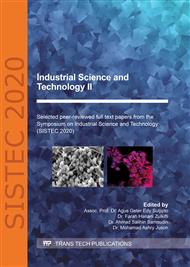[1]
M. Yusoff, H. Hamid, P. Houghton, Anticholinesterase inhibitory activity of quaternary alkaloids from Tinospora crispa, Molecules 19 (2014) 1201-1211.
DOI: 10.3390/molecules19011201
Google Scholar
[2]
A.K. Pathak, D.C. Jain, R.P. Sharma, Chemistry and biological activities of the genera Tinospora, International journal of pharmacognosy 33(1995) 277-287.
DOI: 10.3109/13880209509065379
Google Scholar
[3]
A.C. Dweck, J.-P. Cavin, Andawali (Tinospora crispa): a review, Personal care magazine 7 (2006) 33-39.
Google Scholar
[4]
W. Ahmad, I. Jantan, S.N. Bukhari, Tinospora crispa (L.) Hook. f. & Thomson: a review of its ethnobotanical, phytochemical, and pharmacological aspects, Frontiers in pharmacology 7 (2016) 59.
DOI: 10.3389/fphar.2016.00059
Google Scholar
[5]
H. Hamid, M. Yusoff, M. Liu, M. Karim, α-Glucosidase and α-amylase inhibitory constituents of Tinospora crispa: Isolation and chemical profile confirmation by ultra-high performance liquid chromatography-quadrupole time-of-flight/mass spectrometry, Journal of Functional Foods 16 (2015) 74-80.
DOI: 10.1016/j.jff.2015.04.011
Google Scholar
[6]
T. Takao, F. Kitatani, N. Watanabe, A. Yagi, K. Sakata, A simple screening method for antioxidants and isolation of several antioxidants produced by marine bacteria from fish and shellfish, Bioscience, Biotechnology, and Biochemistry 58 (1994) 1780-1783.
DOI: 10.1271/bbb.58.1780
Google Scholar
[7]
H.A. Hamid, R. Mutazah, M.M. Yusoff, N.A.A. Karim, A.F.A. Razis, Comparative analysis of antioxidant and antiproliferative activities of Rhodomyrtus tomentosa extracts prepared with various solvents, Food and Chemical Toxicology (2016).
DOI: 10.1016/j.fct.2016.10.004
Google Scholar
[8]
S.S. Zeyohanness, H. Abd Hamid, F.H. Zulkifli, Poly (vinyl alcohol) electrospun nanofibers containing antimicrobial Rhodomyrtus tomentosa extract, Journal of Bioactive and Compatible Polymers (2018) 0883911518801040.
DOI: 10.1177/0883911518801040
Google Scholar
[9]
S. Shah, C. Ukaegbu, H. Hamid, O. Alara, Evaluation of antioxidant and antibacterial activities of the stems of Flammulina velutipes and Hypsizygus tessellatus (white and brown var.) extracted with different solvents, Journal of Food Measurement and Characterization (2018) 1-15.
DOI: 10.1007/s11694-018-9810-8
Google Scholar
[10]
A. Cavin, K. Hostettmann, W. Dyatmyko, O. Potterat, Antioxidant and lipophilic constituents of Tinospora crispa, Planta medica 64 (1998) 393-396.
DOI: 10.1055/s-2006-957466
Google Scholar
[11]
H.A. Hamid, A.N.M. Ramli, N. Zamri, M.M. Yusoff, UPLC-QTOF/MS-based phenolic profiling of Melastomaceae, their antioxidant activity and cytotoxic effects against human breast cancer cell MDA-MB-231, Food chemistry 265 (2019) 253-259.
DOI: 10.1016/j.foodchem.2018.05.033
Google Scholar
[12]
L. Račková, M. Májeková, D. Košt'álová, M. Štefek, Antiradical and antioxidant activities of alkaloids isolated from Mahonia aquifolium. Structural aspects, Bioorganic & medicinal chemistry 12 (2004) 4709-4715.
DOI: 10.1016/j.bmc.2004.06.035
Google Scholar
[13]
D. Karou, A. Savadogo, A. Canini, S. Yameogo, C. Montesano, J. Simpore, V. Colizzi, A.S. Traore, Antibacterial activity of alkaloids from Sida acuta, African journal of biotechnology 5 (2006) 195-200.
Google Scholar
[14]
Y. Deng, M. Zhang, H. Luo, Identification and antimicrobial activity of two alkaloids from traditional Chinese medicinal plant Tinospora capillipes, Industrial crops and products 37 (2012) 298-302.
DOI: 10.1016/j.indcrop.2011.12.006
Google Scholar
[15]
K. Iwasa, M. Kamigauchi, M. Sugiura, H. Nanba, Antimicrobial activity of some 13-alkyl substituted protoberberinium salts, Planta medica 63 (1997) 196-198.
DOI: 10.1055/s-2006-957651
Google Scholar
[16]
D.-L. Yang, W.-L. Mei, H. Wang, H.-F. Dai, Antimicrobial alkaloids from the tubers of Stephania succifera, Zeitschrift für Naturforschung B 65 (2010) 757-761.
DOI: 10.1515/znb-2010-0612
Google Scholar


